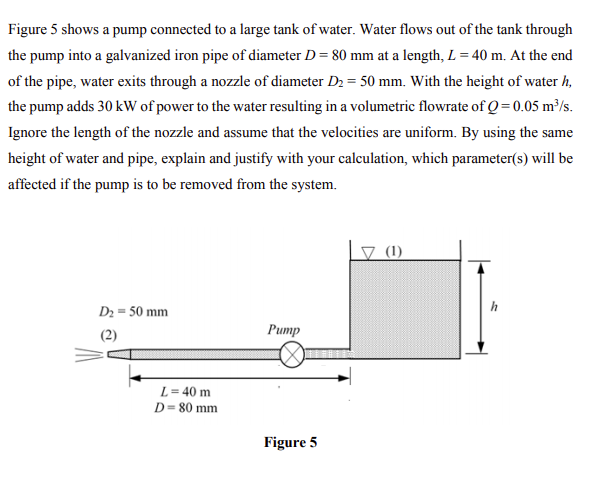Figure 5 shows a pump connected to a large tank of water. Water flows out of the tank through the pump into a galvanized iron pipe of diameter D = 80 mm at a length, L= 40 m. At the end of the pipe, water exits through a nozzle of diameter D2 = 50 mm. With the height of water h, the pump adds 30 kW of power to the water resulting in a volumetric flowrate of Q=0.05 m³/s. Ignore the length of the nozzle and assume that the velocities are uniform. By using the same height of water and pipe, explain and justify with your calculation, which parameter(s) will be affected if the pump is to be removed from the system.
Figure 5 shows a pump connected to a large tank of water. Water flows out of the tank through the pump into a galvanized iron pipe of diameter D = 80 mm at a length, L= 40 m. At the end of the pipe, water exits through a nozzle of diameter D2 = 50 mm. With the height of water h, the pump adds 30 kW of power to the water resulting in a volumetric flowrate of Q=0.05 m³/s. Ignore the length of the nozzle and assume that the velocities are uniform. By using the same height of water and pipe, explain and justify with your calculation, which parameter(s) will be affected if the pump is to be removed from the system.
Elements Of Electromagnetics
7th Edition
ISBN:9780190698614
Author:Sadiku, Matthew N. O.
Publisher:Sadiku, Matthew N. O.
ChapterMA: Math Assessment
Section: Chapter Questions
Problem 1.1MA
Related questions
Question

Transcribed Image Text:Figure 5 shows a pump connected to a large tank of water. Water flows out of the tank through
the pump into a galvanized iron pipe of diameter D = 80 mm at a length, L = 40 m. At the end
of the pipe, water exits through a nozzle of diameter D2 = 50 mm. With the height of water h,
the pump adds 30 kW of power to the water resulting in a volumetric flowrate of Q=0.05 m³/s.
Ignore the length of the nozzle and assume that the velocities are uniform. By using the same
height of water and pipe, explain and justify with your calculation, which parameter(s) will be
affected if the pump is to be removed from the system.
♡ (1)
D2 = 50 mm
h
(2)
Ритp
L= 40 m
D= 80 mm
Figure 5
Expert Solution
This question has been solved!
Explore an expertly crafted, step-by-step solution for a thorough understanding of key concepts.
Step by step
Solved in 2 steps with 1 images

Knowledge Booster
Learn more about
Need a deep-dive on the concept behind this application? Look no further. Learn more about this topic, mechanical-engineering and related others by exploring similar questions and additional content below.Recommended textbooks for you

Elements Of Electromagnetics
Mechanical Engineering
ISBN:
9780190698614
Author:
Sadiku, Matthew N. O.
Publisher:
Oxford University Press

Mechanics of Materials (10th Edition)
Mechanical Engineering
ISBN:
9780134319650
Author:
Russell C. Hibbeler
Publisher:
PEARSON

Thermodynamics: An Engineering Approach
Mechanical Engineering
ISBN:
9781259822674
Author:
Yunus A. Cengel Dr., Michael A. Boles
Publisher:
McGraw-Hill Education

Elements Of Electromagnetics
Mechanical Engineering
ISBN:
9780190698614
Author:
Sadiku, Matthew N. O.
Publisher:
Oxford University Press

Mechanics of Materials (10th Edition)
Mechanical Engineering
ISBN:
9780134319650
Author:
Russell C. Hibbeler
Publisher:
PEARSON

Thermodynamics: An Engineering Approach
Mechanical Engineering
ISBN:
9781259822674
Author:
Yunus A. Cengel Dr., Michael A. Boles
Publisher:
McGraw-Hill Education

Control Systems Engineering
Mechanical Engineering
ISBN:
9781118170519
Author:
Norman S. Nise
Publisher:
WILEY

Mechanics of Materials (MindTap Course List)
Mechanical Engineering
ISBN:
9781337093347
Author:
Barry J. Goodno, James M. Gere
Publisher:
Cengage Learning

Engineering Mechanics: Statics
Mechanical Engineering
ISBN:
9781118807330
Author:
James L. Meriam, L. G. Kraige, J. N. Bolton
Publisher:
WILEY